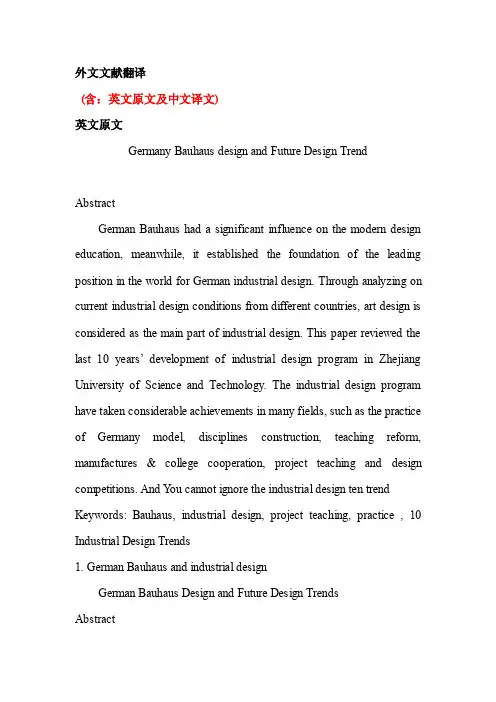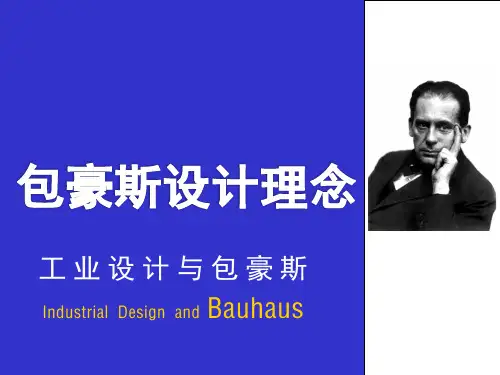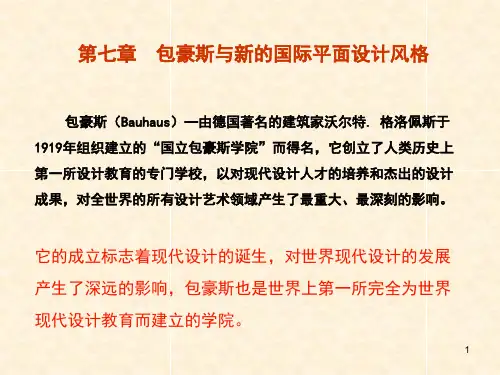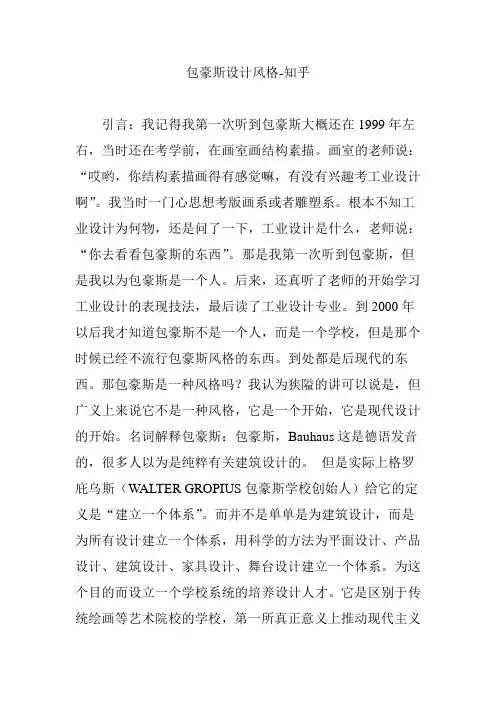包豪斯的工业设计
- 格式:ppt
- 大小:15.67 MB
- 文档页数:58

外文文献翻译(含:英文原文及中文译文)英文原文Germany Bauhaus design and Future Design TrendAbstractGerman Bauhaus had a significant influence on the modern design education, meanwhile, it established the foundation of the leading position in the world for German industrial design. Through analyzing on current industrial design conditions from different countries, art design is considered as the main part of industrial design. This paper reviewed the last 10 years’ development of industrial design program in Zhejiang University of Science and Technology. The industrial design program have taken considerable achievements in many fields, such as the practice of Germany model, disciplines construction, teaching reform, manufactures & college cooperation, project teaching and design competitions. And Y ou cannot ignore the industrial design ten trend Keywords: Bauhaus, industrial design, project teaching, practice , 10 Industrial Design Trends1. German Bauhaus and industrial designGerman Bauhaus Design and Future Design TrendsAbstractGerman Bauhaus has a significant influence. At the same time, modern design education laid the foundation for the world's leading German industrial design. By analyzing the current industrial design conditions in different countries, artistic design is considered as the main industrial design. This article reviews the process of developing industrial designs in the last 10 years. Industrial design programs have taken considerable success in many areas such as the German practice model, professional construction, teaching reform, collaboration between production and engineering colleges, teaching and design competitions and ten trends in industrial design that you cannot ignore.Key words: ten trends of Bauhaus, industrial design, project teaching, practice, industrial design1. German Bauhaus and Industrial DesignIn 1919, the school had built Bauhaus Weimar, Germany. This is known as the “cradle of world industrial design” and the history of this milestone art design. Bauhaus believes that the most important thing is to allow students to explore their own ways of designing, rather than teaching their teachers; to cultivate students' ability to think independently and critically, instead of putting certain design styles on them. Compared with other schools with similar design education, Bauhaus philosophy has a unique philosophy of education. It took a thorough reform of the traditional art design education system andestablished art design as a new professional discipline. At the same time, Walter Gropius, the founder of Bauhaus, put forward the "unified art and technology" as the leading design philosophy of education.One of Bauhaus's works is a general industrial product that actively purifies the form. Bauhaus stressed that the design of the product's shape should be based on basic geometric models such as cubes, squares, and circles. The form of the product, and outlined should be simple and varied in different ways and follow abstract forms of principles and aesthetics. Because of Bauhaus's bravery and active exploration and reform, he took a major influence on the formation of the modernist artistic style and enabled Bauhaus to design a world-class reputation. Therefore Bauhaus became a milestone in the history of modern design art.The American artist Jose Sinel first mentioned the industrial design of the term in 1919. However, in China, until 1983, the Ministry of Education had met the industrial design disciplines and sample major ordinary universities. The original name was "The main product formation was" students for the arts. In 1998, the national priority category was adjusted to be integrated into international conventions. The “major” product formation has long since focused on the human-product-environment relationship in the field of product morphology and other research. This name has replaced "industrial design" and some of the major schools for engineering and art education.Bauhaus has many top European artists during this time, such as Kandinsky and Kerry. They are famous abstract painters. Their teaching trains students and leads to Bauhaus's 20th-century art design. The most famous industrial designers such as Philip Starck behar Marc Newson and Maca graduated from the School of Art Design. Their success proves that industrial design education in art design education is effective. The product form design is still an important aspect. Industrial design in undergraduate industrial design research is currently an important part of the famous Art Design School.The Academy of Art and Design of the Norwegian Royal Academy of Arts, the University Politecnico Duisburg-Esse Milan, the applied sciences and arts of Hannover University (Hanover Industrial Design Division), all of whom belong to the School of Art and Design.According to a survey: the American Association of Industrial Designers (IDSA organized by the United States) in 1998, there are 49 colleges, which have industrial design undergraduate or graduate programs registered on the IDSA-sponsored list. Typical industrial design students are usually set up in art schools and can obtain bachelor degree or above, fine arts or related majors. Most people are accredited to the school NASAD (National Association of Arts and Design). Only 15 - schools are not certified. After five years o f IDSA’s announcement, only registered industrial design students can be recognized. Among them are37 industrial design majors in universities, 6 in design colleges, and 4 in art schools. This situation has not changed in the current year.Asia: In Japan, industrial design majors also set in art schools or independent industrial design faculties, such as Tokyo Zokei University, Musashino Art University, Tama Art University, and University of Tsukuba etc. In Hongkong, The Hong Kong Polytechnic University has famous industrial design programs. In Taiwan, Shih Chien University, National Cheng Kung University, National Yunlin University of Science & Technology have famous industrial design programs. In mainland of China, Jiangnan University, Tsinghua University, Hunan University, Tongji University and the Guangzhou academic of fine arts all have their industrial design departments in the art design schools or departments.2 10 Industrial Design Trends Y ou Can't Ignore2.1 Design For A CauseCompanies including Herman Miller and American Apparel are promoting their ideals through design. Y ves Béhar's leaf lamp for Herman Miller (shown) uses a biomorphic grid of LEDs, which consume 40% percent less energy than fluorescent lights and last for 100,000 hours. And Nike plans to make its entire footwear line out of sustainable materials by 2010.2.2 SimplexitySteve McCallion, executive creative director of Portland, Ore.-basedindustrial design firm Ziba Design, says there's a trend toward "simplexity," products that have many functions but are approachable, ergonomically correct and easy to use--like Apple's iPhone. The baby boomers have also propelled simplexity; as the generation ages, the need for easy-to-use, at-home medical equipment becomes greater. Ami V erhalen, director of industrial design at Madison, Wis.-based Design Concepts, says that in-home health care will be a huge driver for product innovation in the upcoming decade.2.3 PersonalizationFrom Nike ID shoes to Build-a-Bear teddies, retailers are adding a "build your own" element to brands. Do it yourself--or DIY--serves as an important element of this trend. Publications like Ready Made magazine and books like designer Wendy Mullin's Sew U encourage consumers to put their own spin on things.2.4 GlobalizationLike other industries, outsourcing has affected international design. Today a designer in Delhi might be working with a manufacturer in Columbus. Steve McCallion says that the globalization of product design has created Internet communities that enable more people to participate in the design process. Companies like Kid Robot can employ toy designers from Tokyo to Tucson with greater ease than ever.2.5 OrnamentationIn fashion design, we're seeing a return to minimalism, but in home decor, ornate details are in fashion. For the first time in decades, wallpaper is in fashion, and the details are rich--brocades, velvets and jewel-tone colors. Long-forgotten textile designers like Florence Broadhurst and V era Neumann are receiving attention from a new generation of design-savvy consumers.2.6 Polarization Of DesignBig-box or luxury retailer? Many experts say that design has been polarized, with innovative products available at both the very high end (Neiman Marcus, Moss) and the very low end (Target, Ikea). Meanwhile, midrange retailers like Macy's suffer from lack of fresh, on-trend ideas. That isolates the huge chunk of the population that can afford something higher-end than the $200 Malm bed at Ikea but scoff at the price of a $16,000 Hastens mattress.2.7 Pink DesignGadgets are a guy's game, right? Not if you consider the latest products with feminine mystique. Motorola released a lipstick pink Razr cellphone, and more recently, LG released a Prada phone. More and more manufacturers are creating sleeker, feminized versions of their clunky, chunky products, and both men and women are biting. Want proof of the feminization of product design? Just check out , which rates several items a day as "Geek chic" or "Just Plain Geeky."2.8 Mass ImperfectionSome designers are creating intentionally flawed pieces, like designer Jason Miller's duct tape chair or Bodum's Pavina glassware collection, which uses mouth-blown double-walled glass, giving each piece a slight variation in height, thickness and weight. Whiskered and weathered textiles--on denim as well as furniture and tapestries--are more recognizable examples of intentional imperfection in production.2.9 CraftAs mass retailers like Target become more design-focused, there's a countertrend of independent manufacturers and designers creating one-off, heirloom pieces. Where to find these limited-edition treasures? Artisan e-commerce sites like , classical craft companies like Heath Ceramics and modernist design houses such as Design Within Reach.2.10 Focus On The Other 90%Anthony Pannozzo, vice president of design strategy at Waltham, Mass.-based firm Herbst LaZar Bell, says that well-designed products are available to only 10% of the world's population. However, more and more designers are starting to cater to consumers in Africa, Asia and Latin America.中文译文德国包豪斯设计与未来设计趋势摘要德国包豪斯有显著的影响, 与此同时, 现代设计教育奠定了基础, 它处于世界领先地位的德国工业设计。



工业设计的流派与组织大流派工业设计是一门专注于为产品和系统设计的学科,旨在创建具有良好外观、功能和用户体验的产品。
随着时间的推移,工业设计产生了不同的流派和组织大流派,这些流派是根据不同的设计理念和方法论而形成的。
本文将介绍几个著名的工业设计流派和组织大流派。
1. 功能主义:功能主义是工业设计领域最早的流派之一,主张以功能为中心设计产品。
功能主义追求产品的实用性、效率和直观性,并且强调产品设计应该是透明和无欺骗性的。
该流派的代表人物包括德国设计师迪特·拉姆斯和美国设计师Raymond Loewy,他们的设计作品强调产品的功能和简洁性。
2.包豪斯派:包豪斯派是工业设计领域的一个重要流派,起源于德国包豪斯学派。
包豪斯派主张将艺术和工艺相结合,强调简洁、功能性和工业化生产。
包豪斯派的设计师们追求形式和功能的一体化,注重几何形状、纯净色彩和材料的实用性。
这个流派的代表人物包括包豪斯学派的创始人沃尔特·格罗皮乌斯和拉斯·莫尔纳。
3.风格和装饰派:风格和装饰派是一种注重奢华和装饰性的设计风格。
这个流派将产品设计为尽可能华丽和精美的形式,注重细节并使用高级材料和装饰。
这种设计流派的代表包括法国设计师雷蒙德·古内和乔治·梅丽。
4.可持续设计:可持续设计是近年来工业设计领域的一个重要流派,强调产品设计需要考虑环境和社会影响。
可持续设计追求减少资源消耗、延长产品寿命周期和降低对环境的负面影响。
这个流派的代表人物包括瑞典设计师范·默瑟斯和丹尼斯·梅托兰德。
除了这些流派之外,工业设计领域还有一些组织大流派,这些组织致力于推动和发展工业设计。
1. 国际工业设计协会(Icsid):国际工业设计协会是一个国际性的工业设计组织,由全球各地的工业设计师和学者组成。
该组织致力于促进工业设计的发展,推动设计的创新和可持续发展。
2.美国工业设计师协会(IDSA):美国工业设计师协会是美国最大的工业设计组织,汇集了美国各地的工业设计师。





包豪斯设计风格-知乎引言:我记得我第一次听到包豪斯大概还在1999年左右,当时还在考学前,在画室画结构素描。
画室的老师说:“哎哟,你结构素描画得有感觉嘛,有没有兴趣考工业设计啊”。
我当时一门心思想考版画系或者雕塑系。
根本不知工业设计为何物,还是问了一下,工业设计是什么,老师说:“你去看看包豪斯的东西”。
那是我第一次听到包豪斯,但是我以为包豪斯是一个人。
后来,还真听了老师的开始学习工业设计的表现技法,最后读了工业设计专业。
到2000年以后我才知道包豪斯不是一个人,而是一个学校,但是那个时候已经不流行包豪斯风格的东西。
到处都是后现代的东西。
那包豪斯是一种风格吗?我认为狭隘的讲可以说是,但广义上来说它不是一种风格,它是一个开始,它是现代设计的开始。
名词解释包豪斯:包豪斯,Bauhaus这是德语发音的,很多人以为是纯粹有关建筑设计的。
但是实际上格罗庇乌斯(WALTER GROPIUS包豪斯学校创始人)给它的定义是“建立一个体系”。
而并不是单单是为建筑设计,而是为所有设计建立一个体系,用科学的方法为平面设计、产品设计、建筑设计、家具设计、舞台设计建立一个体系。
为这个目的而设立一个学校系统的培养设计人才。
它是区别于传统绘画等艺术院校的学校,第一所真正意义上推动现代主义运动的设计学校。
而现代主义运动的核心是设计为功能服务为第一位。
这是完全区别于以往千百年来设计更多注重形式的伟大变革,因为以前所有产品涉及设计都是为权贵服务的,他们需要的更多是彰显自身地位、权利、金钱的形式。
同时,这也是建立在工业化大生产、流水线、标准化制作的时代背景上的。
应该可以说是现代化设计的里程碑。
前世今生:但是,包豪斯学校真正存在的时间只有1919-1933年短短的14年时间,先后3迁校址魏玛、德绍、柏林,最后在柏林就被希特勒派军队撤销了这个学校。
这里30多个老师,总共培养了1200多个学生,鸟兽散,大多流亡海外,包豪斯体系最重要的2个老师,格罗庇乌斯、密斯凡罗德都去了美国。

包豪斯对现代工业的贡献包豪斯:1919年德意志帝国改制为魏玛共和国,百废待兴中,成立了一个培养新型设计人才的学校——包豪斯。
这座被称为现代设计教育起点的学院,经受住数次搬迁、政治干预和最终关闭的考验。
如同一个源泉,让现代主义思潮逐渐成为一股滚滚洪流,最终席卷世界,无处不在无人不知。
百年间,尽管世界已经天翻地覆,包豪斯所带来的影响力,依然在建筑、设计、艺术等学科中不断被提及,甚至吸引了更广泛的公众的兴趣。
至今影响着全世界的现代工业发展,包豪斯对现代工业的贡献主要体现在以下几个方面:1.设计与艺术的统一:包豪斯提倡艺术与设计的统一,认为艺术应该服务于工业,而工业设计应该追求美。
这种理念打破了当时艺术与工业的对立,使得设计与艺术的界限逐渐模糊,同时也使得工业产品的美学价值得到提升。
2.技术与艺术的结合:包豪斯强调技术的地位,认为技术应该与艺术相结合。
因此,包豪斯的学生需要同时学习艺术与技术,以便能够将技术与艺术完美结合,创造出既有技术含量又具有美学价值的工业产品。
3.批量化生产:包豪斯提倡批量化的生产方式,以满足当时社会对大量工业产品的需求。
同时,批量化的生产方式也使得工业产品的成本降低,让更多的人能够享受到工业产品的便利。
4.功能主义的设计理念:包豪斯认为设计应该以功能主义为核心,强调产品的功能性。
这种理念使得工业产品的设计更加注重其实用性,而不是仅仅追求外观的美观。
5.建立现代设计教育体系:包豪斯不仅是一个设计学院,更是一个设计教育的体系。
它建立了一套完整的现代设计教育体系,包括设计理论、设计实践和设计技术等,为现代设计教育的发展奠定了基础。
6.包豪斯对现代工业的贡献在于它打破了传统的设计观念,提倡艺术与设计的统一、技术与艺术的结合、批量化生产、功能主义的设计理念以及建立现代设计教育体系等。
这些理念对现代工业设计的发展产生了深远的影响。

详细介绍:包豪斯(Bauhaus)作为一种设计体系在当年风靡整个世界,在现代工业设计领域中,它的思想和美学趣味可以说整整影响一代人。
虽然后现代主义的崛起对包豪斯的设计思想来说是一种冲击、一种进步,但包豪斯的某些思想、观念对现代工业设计和技术美学仍然有启迪作用,特别是对发展中国家的工业设计道路的方向的选择是有帮助的。
它的原则和概念对一切工业设计都是有影响作用的。
弗兰克·皮克(FrankPick)认为:“……必须制定一种压倒一切的科学原则和概念,来指导日用品的设计,象建筑方面那些指导房屋设计的原则那样。
”包豪斯前后经历了三个发展阶段:第一阶段(1919—1925年),魏玛时期。
格罗皮乌斯(WALTER GROPIUS)任校长,提出“艺术与技术新统一”的崇高理想,肩负起训练20世纪设计家和建筑师的神圣使命。
他广招贤能,聘任艺术家与手工匠师授课,形成艺术教育与手工制作相结合的新型教育制度;第二阶段(1925—1932年),德绍时期。
包豪斯在德国德绍重建,并进行课程改革,实行了设计与制作教学一体化的教学方法,取得了优异成果。
1928年格罗皮乌斯辞去包豪斯校长职务,由建筑系主任汉内斯·梅耶(HANNS MEYER)继任。
这位共产党人出身的建筑师,将包豪斯的艺术激进扩大到政治激进,从而使包豪斯面临着越来越大的政治压力。
最后梅耶本人也不得不于1930年辞职离任,由密斯·凡·德·罗(MIES VAN DE ROHE)继任。
接任的密斯面对来自纳粹势力的压力,竭尽全力维持着学校的运转,终于在1932年10月纳粹党占据德绍后,被迫关闭包豪斯;第三阶段(1932—1933年),柏林时期。
密斯·凡·德·罗将学校迁至柏林的一座废弃的办公楼中,试图重整旗鼓,由于包豪斯精神为德国纳粹所不容,面对刚刚上台的纳粹政府,密斯终于回天无力,于该年8月宣布包豪斯永久关闭。
包豪斯对现代设计教育的影响和贡献包豪斯是1919年在德国建立的一所艺术设计学院,也是世界上第一所完全发展艺术设计教育的学院。
包豪斯的创始人是德国著名的设计师、艺术设计理论家沃尔特.格罗皮乌斯。
格罗皮乌斯用“包豪斯”来命名有两层意思:第一,狭义地讲,格罗皮乌斯把艺术设计和建筑看作是同源的,艺术设计应该像建筑一样,把各种空间艺术统一于一体,恢复、重建艺术和技术、艺术创作和生产的联系;第二,广义地讲,“建筑之地"作为“大厦”是一种理想、象征和隐喻。
各种艺术设计力量围绕建造“大厦”这项共同任务联合起来,通过艺术手段来塑造完整的、符合人性的环境。
可见,从其命名的意义来看,包豪斯的思想、宗旨就已经显而易见了。
包豪斯前后经历了三个发展阶段:包豪斯虽然仅仅在14年时间,但它却对现代主义艺术设计的发展作出了不可磨灭的贡献。
包豪斯的历史贡献体现在它的艺术设计思想、一系列的艺术设计实践和它所开创的现代艺术设计教育体系等方面。
早在包豪斯建立之初,格罗皮乌斯在《包豪斯宣言》中,就明确强调包豪斯的艺术设计思想、宗旨就是要使艺术与设计达到新的统一。
而这个新的统一,实质上是建立“一幢将建筑、雕塑和绘画结合三位一体的新的未来殿堂,并用千百万艺术工作者的双手将之屹立在云霄高处",也就是说,要建立一个艺术与手工艺紧密结合的统一体。
包豪斯强调艺术设计的功能主义、理性主义和艺术设计的自然属性,以及艺术设计要遵循事物的客观规律等思想、精神,深深地凝结在其设计的产品体系中。
尤其难能可贵的是,它在教学实践中,贯彻了“与传统学院教育不同的‘双规教育学制',即由一名形体师傅和一名技术师傅同时从艺术与技术两方面教授学生,使学生的艺术想象力与实际制作能力有机的结合起来,从而产生创造力"的教育精神。
就其倡导的“艺术与技术新统一”的精神来说,包豪斯继承了莫里斯以来的现代主义艺术设计思想,而又把其发展到了更加理性的高度,并在实践中具体运用,这不仅使包豪斯成为欧洲现代艺术设计的集大成者,而且影响到整个20世纪,乃至当代的世界艺术、艺术设计。
简述包豪斯以及其对现代设计的影响。
答:1.包豪斯 (名词解释):包豪斯是1919 年在德国魏玛成立的一所设计学院,这也是世界上第一所推行现代改计教育、有完整的设计教育宗旨和教学体系的学院,其目的是培养新型设计人才,1933 年被德国法西斯关闭,其创始人是德国著名建筑设计师、设计理论家沃尔特·格罗佩斯。
包豪斯的建立与发展是拉斯金、莫里斯及后来的德国工业同盟以来的优秀设计思想与20 世纪欧洲经济发展的必然结果,它的出现对现代设计理论、现代主义设计教育和实践,以及后来的设计美学想想,都具有划时代意义。
包豪斯经过设计实践,形成了重视功能、技术和经济因素的正确的设计观念,其设计思想的核心为:坚持艺术与技术的新统一;设计的目的是人而不是产品;设计必须遵循自然与客观的法则进行。
这些观点对现代工业设计的发展起到了积极作用,使现代设计逐步由理想主义走向现实主义,即用理性的、科学的思想来替代术上的自我表现和浪漫主义。
包豪斯的历史虽然比较短暂,但在设计史上的作用是重要的,包豪斯建立了一整套设计教学方法和体系,重视科学技术和艺术在课程中的结合,给后来的艺术设计教学体系的建立、发展奠定了基础。
包豪斯遵循的设计思想和实践观点真正实现了技术与艺术的统一,形成了理性主义的设计原则,开创了面向现代工业的设计。
包豪斯是工业设计史、现代建筑史、现代艺术史上的个重要里程碑,是艺术设计作为一门学科确立的标志,是现代设计的摇篮。
由于所处的历史时期的原因,包豪斯本身也存在着一定的局限性,如对于人的心理需求重视不够,缺少对人的情感的关注。
2.第一阶段 (1919—1925 年),魏玛时期。
格罗佩斯任校长,提出“艺术与技术新统一”的崇高理想,肩负起训练20 世纪设计家和建筑师的神圣使命.他广招贤能,聘任艺术家与手工匠师授课 ,形成艺术教育与手工制作相结合的新型教育制度;第二阶段(1925—1932 年),德绍时期。
包豪斯在德国德绍重建,并进行课程改革,实行了设计与制作教学一体化的教学方法, 取得了优异成果.1928 年格罗皮乌斯辞去包豪斯校长职务,由建筑系主任汉内斯·梅耶继任,这位共产党人出身的建筑师,将包豪斯的艺术激进扩大到政治激进,从而使包豪斯面临着越来越大的政治压力.最后梅耶本人也不得不于1930 年辞职离任,由米斯·凡·德·罗继任接任的密斯面对来自纳粹势力的压力,竭尽全力维持着学校的运转,终于在1932 年 10 月纳粹党占据德绍后,被迫关闭包豪斯;第三阶段(1932—1933 年),柏林时期 .米斯·凡·德·罗将学校迁至柏林的一座废弃的办公楼中,试图重整旗鼓,由于包豪斯精神为德国纳粹所不容,面对刚刚上台的纳粹政府,密斯终于回天无力,于该年8 月宣布包豪斯永久关闭。